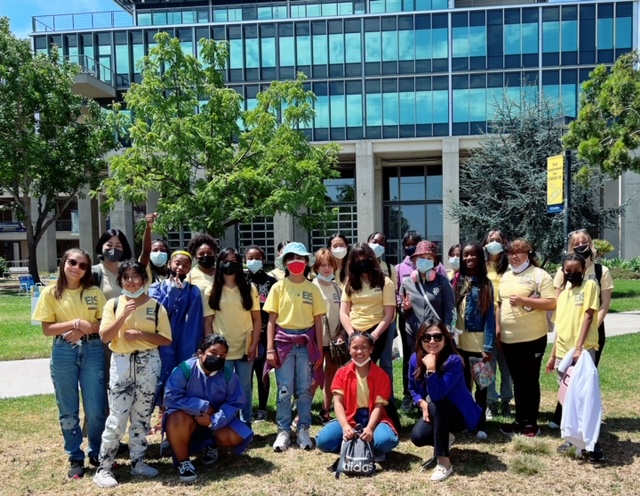OPALS, The Shimmering Next Generation
September 20, 2022
Generating subcellular damage using a laser and picking strawberries from local farm fields, summer was filled with immense excitement for high school interns here at the University of California, San Diego. This year IEM launched the OPALS program, a six-week internship aimed at providing high school students with hands-on experience in a research laboratory setting. OPALS follows a transition from the previous Biophotonics Outreach program established in 2018, which was briefly online for the duration of the COVID-19 pandemic. OPALS 2022 was conducted mostly in person and is run by Linda Shi of the Berns lab. Shi has worked in biophotonics for over 18 years with an engineering background in China and received her Ph.D. in the States.
This year, OPALS enrolled 38 students from different parts of the world. The number of students participating in the program has seen a gradual increase since 2018. Interns were split into 9 groups and each researched and developed their own projects to be presented at the end of the program. Project topics ranged from axon stress testing to lysosomal and mitochondrial tracking to DNA repair. They worked with technologies such as laser microscopy and laser imaging in order to analyze cell lines. 90% of students were even able to get a certification in MatLab from Mathworks.
The 2022 Summer OPALS interns.
Differences in conducting the program from Biophotonics included the presence of various guest speakers such as professors, previous interns, and even an architect. Around 80% of the interns expressed an interest in pursuing a profession in medicine in the future, and as such, Shi brought in various healthcare professionals such as doctors, physician assistants, and physical therapists to present and lecture to the interns. One speaker, Dr. Jaime Chen, even demonstrated some of his own equipment to the students. The program also consisted of lab tours, one of which was to visit Dr. Michael Berns’ Biophotonics Center located at the University of California, Irvine. Another visit was to an earthquake testing facility. “I find it really important to give the students a broader view of what opportunities are available in engineering,” says Shi, “I wanted these lab visits to show them what’s out there.”
OPALS also hosted visitors from the Elementary Institute of Science (EIS), a program aimed at middle school students with low-income backgrounds. Students were shown fixed cells and red blood cells to demonstrate the use of an inverted microscope. Shi, in the future, hopes to continue to host the EIS program here at UCSD.

Students from the Elementary Institute of Science visit UC San Diego’s Student Center.
Shi also acknowledges the importance of providing a balance of work and leisure activities for the interns. The program included trips to the Birch Aquarium, visits to Old Town San Diego, strawberry picking in Carlsbad, and UCSD’s own challenge courses. These events were not possible before as the Biophotonics internship was hosted entirely online for the last two years. “Being able to do this program in person was so much more meaningful,” says Shi. “Some of the students [who] returned from last year… were so happy [to be] able to see their friends face-to-face.”
The interns are on a trip to Old Town San Diego.
The most rewarding part of the program for Shi was to support her students’ learning and see the incredible amount of growth they had obtained by the end of the program. She is driven by a passion to help students learn, encourages them as a mentor, and is unafraid to extend this passion to their families as well. “My students are so precious to me, and I wanted to let the parents know how important it is to encourage the students at home and to cheer them on. Something I told my students is that no matter what you do, try your best. Even though you aren’t exposed to some of these things, you are still learning and know what direction to take.”
At the end of the program, Shi rewarded the students with stuffed animals as they presented their projects. The interns were all very appreciative of the friendship and connections they made during the six-week internship. Although summer comes to a close for OPALS, this does not stop the interns from continuing their own research endeavors. Two interns presented their posters at SPIE Translational Biophotonics Conference on Sept. 13 in LA. Four posters were accepted by the Biomedical Engineering Society (BMES) . Four interns will present their results/findings on October 13 in San Antonio, Texas. Shi is also coordinating new projects with some of the interns who wish to continue working with her into the following school year.
The students with their stuffed animals in celebration of completing OPALs
As for future plans, Shi wants to continue the summer program next year. She aims to start reaching out to more students from underrepresented and low-income backgrounds. “Since this year was the 1st year, we didn’t spend as much time preparing for it and it was much less structured and very confusing. I also had to talk to a lot of different labs to organize the visits.” Shi is very optimistic about making next year even better as she has established a firm network and has several ideas on how to make the program more structured. Most of all, Shi is extremely grateful for the opportunity to be able to run this program. “I appreciate everything that IEM has done for me and I hope to continue working in this direction.”
Applications for the next wave of interns are projected to open around January. To learn more about OPALS, visit their website here. To see highlights from OPALS click this link.
